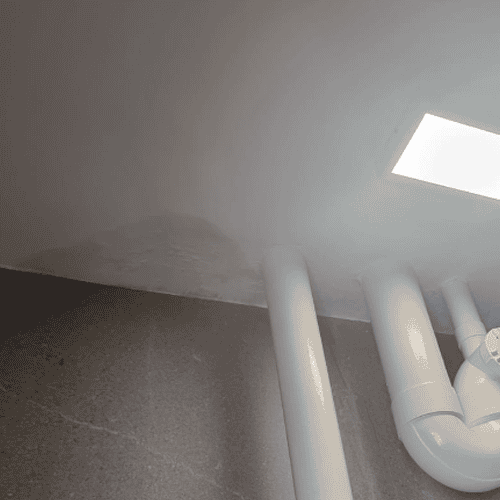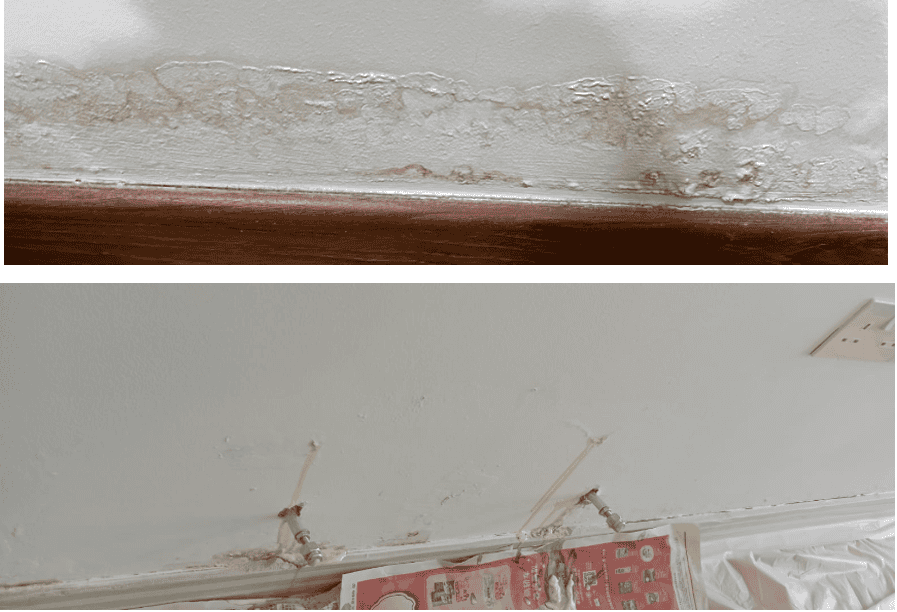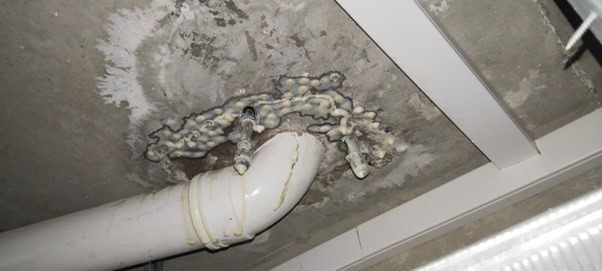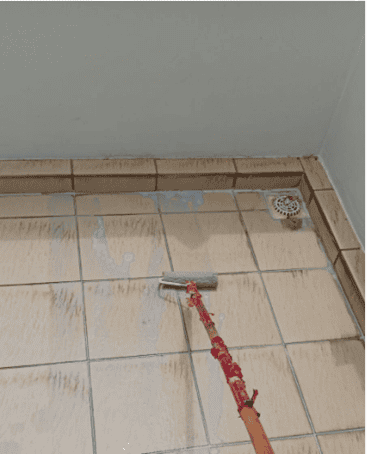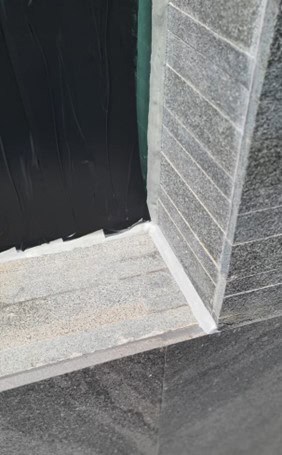Water stains on walls and ceilings are not just unsightly; they often indicate underlying issues that need prompt attention. In Singapore’s tropical climate, where humidity and occasional heavy rains are common, waterproofing is crucial in protecting your home from water damage.
Water stains on bathroom walls and ceilings are often the first visible signs of water leakage or seepage. Here are some common signs and symptoms to watch out for:
- Discoloration:
Yellowish or brownish stains on walls or ceilings, especially near plumbing fixtures like sinks, showers, or toilets.
- Peeling or Bubbling Paint:
Paint that is peeling, bubbling, or flaking off can indicate water damage underneath.
- Musty Odors:
Damp areas can lead to musty or moldy smells, signaling the presence of moisture.
- Visible Mold or Mildew:
Black or greenish patches of mold or mildew may appear on walls or ceilings affected by water leaks.
- Softened or Warped Surfaces:
Walls or ceilings that feel soft, spongy, or warped to the touch may have water damage.
These signs often indicate ongoing water leakage or seepage, which, if left unaddressed, can lead to more significant structural issues and mold growth.
Causes of Wall and Ceiling Staining:
Understanding the underlying causes of wall and ceiling stains is crucial for effective remediation. Here are some common factors that can lead to staining:
- Poor Waterproofing:
Inadequate waterproofing in bathrooms, balconies, or terraces can result in water seepage through walls or ceilings. This can be due to improper sealing of joints, gaps in waterproof membranes, or degraded waterproofing materials.
Water from showers, baths, or splashes can penetrate through weak waterproofing layers, causing stains and water damage over time.
- Condensation:
High humidity levels combined with poor bathroom ventilation can lead to condensation build-up on walls and ceilings. This moisture can promote mold growth and cause discoloration and stains.
Improperly insulated walls or ceilings can also contribute to condensation issues, especially in areas with significant temperature differences.
- Structural Issues:
Cracks, gaps, or holes in walls or ceilings provide pathways for water intrusion. These structural issues can result from the settling of the building, seismic activity, or construction defects.
Water can enter through these openings during rainstorms or plumbing leaks, leading to stains and water damage within the building envelope.
Damage to the roof, such as missing shingles, cracked flashing, or deteriorated sealant, can allow rainwater to infiltrate into the ceiling space.
Roof leaks often manifest as water stains on the ceiling, particularly near the affected roof area.
- Leaking Pipes:
Old or corroded pipes can develop leaks over time, especially in areas with high water pressure. These leaks can be slow and gradual, leading to water seepage into walls or ceilings.
Common areas where pipe leaks occur include behind walls, under sinks, and around plumbing fixtures in bathrooms.
Addressing these underlying factors through proper maintenance, repairs, and waterproofing measures is essential to prevent recurrent staining and water-related issues in walls and ceilings.
Identifying and addressing the root cause of the staining is essential to prevent further damage and ensure long-term protection against water-related issues.
Types of Water Leaks That Cause Stains on Walls and Ceilings
Different types of water leaks can contribute to stains on walls and ceilings. Understanding these leaks can help in identifying and addressing the source of the problem. Here are the common types of water leaks:
- Roof Leaks:
Roof leaks occur when water infiltrates through damaged or compromised areas of the roof, such as missing shingles, cracked flashing, or deteriorated sealant.
Water from roof leaks can travel downward, causing stains and water damage on ceilings and upper walls.
- Bathroom Waterproofing Failures:
In bathrooms, waterproofing failures can lead to water seepage through walls or floors. This can result from poorly sealed joints, gaps in waterproof membranes, or degraded waterproofing materials.
Water leaks in bathrooms often manifest as stains, discoloration, or mold growth on walls and ceilings, especially in areas near showers, baths, or sinks.
- Condensation and Moisture Buildup:
Condensation and moisture buildup due to high humidity levels and poor ventilation can lead to water stains on walls and ceilings, particularly in bathrooms and other moisture-prone areas.
Improper insulation or ventilation can exacerbate condensation issues, causing persistent staining and mold growth over time.
- Plumbing Leaks:
Leaks in plumbing pipes, joints, or fittings can result in water seepage into walls or ceilings. These leaks may occur in supply lines, drain pipes, or sewage lines.
Common signs of plumbing leaks include water stains, dampness, and mold growth near plumbing fixtures or along walls and ceilings.
Identifying the type of water leak is crucial for implementing targeted repair and waterproofing solutions to prevent further damage and maintain a dry and healthy indoor environment.
Addressing seepage problems on walls and ceilings requires a systematic approach to identify and rectify the underlying issues. Start by identifying the source of the water seepage. This may involve inspecting plumbing fixtures, checking for roof leaks, examining waterproofing in bathrooms, and assessing structural integrity for potential entry points. If plumbing leaks are identified, repair or replace damaged pipes, joints, or fittings. Ensure proper sealing and insulation to prevent future leaks. Address roof leaks by repairing damaged shingles, flashing, or sealant. Consider professional roof inspection and maintenance to prevent recurrent leaks. Seal cracks, gaps, or holes in walls and ceilings to prevent water intrusion.
Common solutions and techniques used for fixing
Roof Leak Repair:
Inspect the roof for damage, such as missing shingles, cracked flashing, or damaged sealant. Replace missing or damaged shingles, repair flashing, and reapply waterproof sealant as needed. Consider engaging a professional roof inspection and maintenance for long-term protection against leaks.
Waterproofing Solutions:
In bathrooms and water-prone areas, apply waterproofing solutions such as waterproof membranes, coatings, or sealants. Ensure proper installation and sealing of joints, corners, and edges. Use waterproof grouts and caulks for tiled surfaces.
PU (Polyurethane) Injection Grouting:
PU (polyurethane) injection grouting is a common technique used to seal cracks and voids in concrete walls and ceilings. The process involves injecting PU grout into cracks under pressure, expanding to fill and seal the gaps effectively.
PU (Polyurethane) injection grouting is a widely used technique in Singapore for repairing cracks, voids, and leaks in concrete structures, including walls and ceilings. It offers excellent flexibility and adhesion, making it suitable for a wide range of applications, including roofs, balconies, and bathrooms.
PU injection grouting involves injecting polyurethane resin into cracks or voids within concrete surfaces. The resin is typically in liquid form but expands upon injection to fill and seal the cracks effectively.
The injection process is carried out using specialized equipment, such as injection pumps and injection ports. The resin is injected under pressure, ensuring thorough penetration into the crack or void.
PU resin expands to fill even small cracks and voids, providing a tight seal against water intrusion. This helps prevent further leakage and water damage. PU resin cures rapidly upon injection, allowing for swift repairs and minimal disruption to daily activities. Polyurethane resins have excellent flexibility and adhesion properties, making them suitable for dynamic structural movements without compromising the seal. PU injection grouting creates a waterproof barrier, enhancing the overall waterproofing of concrete structures. The flexibility of PU resin allows it to accommodate minor movements in the structure, reducing the risk of future cracking and water intrusion.
PU injection grouting as part of your waterproofing and seepage repair strategy, can address cracks and leaks in walls and ceilings, enhancing their durability and waterproofing capabilities.
Clear Penetrative Treatment (CPT)
Clear Penetrative Treatment is a waterproofing membrane coating that is an essential component of waterproofing systems used to protect flooring and walls from water intrusion and damage.
Membrane coats are available in liquid form and can be brushed, rolled, or sprayed onto surfaces for seamless waterproofing.
Waterproofing membranes come in various types, including liquid-applied membranes, and cementitious membranes. Clear Penetrative Treatment (CPT) are fluid-based coating that can be brushed, rolled, or sprayed onto surfaces. They form a seamless and flexible waterproof barrier when cured. Multiple coats may be applied for increased thickness and durability. The primary function of Clear Penetrative Treatment (CPT) is to create a waterproof barrier that prevents water penetration into floors and walls. High-quality membrane coats are durable and long-lasting, providing reliable protection against water damage for extended periods. It can be applied seamlessly, ensuring comprehensive coverage and minimizing potential weak points.
By utilizing Clear Penetrative Treatment (CPT) as part of your waterproofing strategy for floors, and walls, you can achieve durable, seamless, and long-lasting protection against water damage, leaks, and moisture intrusion.
Waterproofing Sealants:
Repair cracks in walls and ceilings using appropriate crack fillers or sealants. Clean the crack, apply the filler/sealant, and smooth it out for a durable and waterproof seal.
Waterproofing sealants are versatile products used to create a watertight seal on various surfaces, including walls, ceilings, roofs, and joints. Waterproofing sealants create a barrier that prevents water penetration, protecting surfaces from moisture damage and leaks.
Polyurethane sealants offer excellent adhesion, flexibility, and resistance to weathering and UV exposure. They are commonly used for joint sealing and waterproofing.
Many sealants offer flexibility to accommodate structural movements without cracking or losing adhesion. Sealants adhere well to various substrates, including concrete, masonry, metal, wood, glass, and plastics. High-quality sealants are durable and long-lasting, providing reliable waterproofing protection for extended periods.
By using waterproofing sealants correctly and maintaining them as needed, you can create a reliable and long-lasting waterproof barrier on walls, ceilings, roofs, and other surfaces, protecting your property from water damage and leaks.
Consider hiring licensed waterproofing contractors or specialists for complex seepage problems. They can perform thorough inspections, recommend tailored solutions, and execute professional waterproofing techniques such as membrane installation, injection grouting, and leak sealing seepage problems on walls and ceilings. Hiring a reputable waterproofing leakage contractor is crucial for ensuring the quality and effectiveness of waterproofing and sealing work on walls and ceilings.
By considering the factors and selecting a reputable contractor, you can ensure that your walls, ceilings, and building structures receive quality waterproofing solutions, protecting them against water damage and leaks effectively.
SWC Construction specializes in waterproofing and utilizing advanced Polyurethane (PU) injection grouting technology, delivering effective waterproofing solutions for industrial, commercial, and residential properties. With over 20 years of experience in waterproofing, our track record of positive Google reviews reflects our commitment to providing quality and excellent service to our clients.
Contact us today to explore our services and receive guidance on addressing your waterproofing or roof leakage concerns. We provide a comprehensive on-site inspection of your property, enabling us to offer customized professional recommendations tailored to your specific needs following the inspection.



